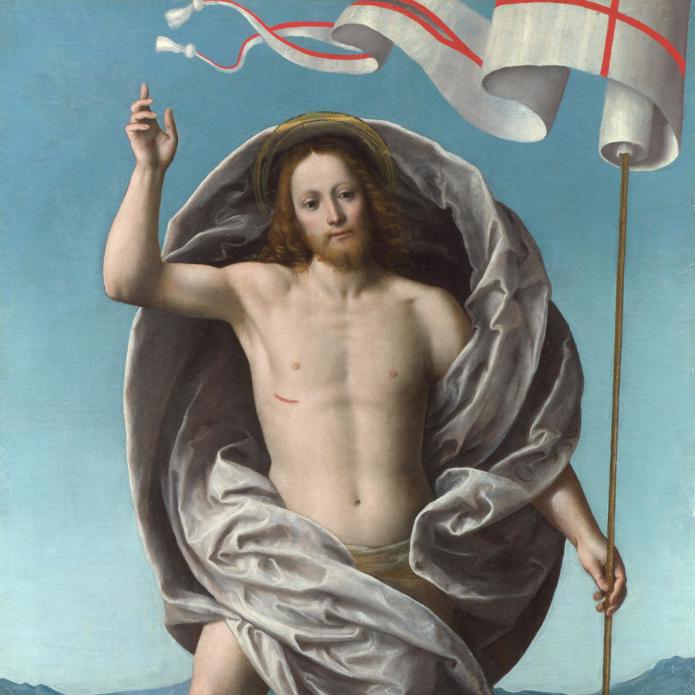Gaudenzio Ferrari, 'Saint Andrew (?)', about 1540
About the work
Overview
A saint, almost certainly Andrew, stands on a hillock in a mountainous landscape. On his right shoulder he supports the cross on which he was crucified. Andrew’s cross is usually depicted as an X-shaped saltire, but here it is T-shaped. Andrew had insisted that the cross on which he was to be martyred should not resemble that of Christ.
This painting was one of the panels of the high altarpiece from the church of S. Pietro at Maggianico, near Lecco, on the shore of Lake Como.It was in the centre of the lower part of the altarpiece with Saints Peter, Bernard, Ambrose and Anthony at its sides. Christ rising from the Tomb (also in the National Gallery collection), was the central panel of the altarpiece; it was flanked by Saint Roch and Saint Christopher carrying the infant Christ. The lowest row of panels (known as the predella), now in the Castello Sforzesco, Milan, is monochrome and depicts scenes of Christ and the apostles.
Key facts
Details
- Full title
- Saint Andrew (?)
- Artist
- Gaudenzio Ferrari
- Artist dates
- active 1508; died 1546
- Part of the series
- Two Panels from a High Altarpiece from Maggianico
- Date made
- about 1540
- Medium and support
- oil on wood
- Dimensions
- 150.5 × 84.5 cm
- Acquisition credit
- Mond Bequest, 1924
- Inventory number
- NG3925
- Location
- Not on display
- Collection
- Main Collection
Provenance
Additional information
Text extracted from the ‘Provenance’ section of the catalogue entry in Cecil Gould, ‘National Gallery Catalogues: The Sixteenth Century Italian Schools’, London 1987, and supplemented by Carol Plazzotta, February 2025; for further information, see the full catalogue entry.
Bibliography
-
1962Gould, Cecil, National Gallery Catalogues: The Sixteenth Century Italian Schools (excluding the Venetian), London 1962
-
1987Gould, Cecil, National Gallery Catalogues: The Sixteenth Century Italian Schools, London 1987
-
2001
C. Baker and T. Henry, The National Gallery: Complete Illustrated Catalogue, London 2001
About this record
If you know more about this painting or have spotted an error, please contact us. Please note that exhibition histories are listed from 2009 onwards. Bibliographies may not be complete; more comprehensive information is available in the National Gallery Library.
Images
About the series: Two Panels from a High Altarpiece from Maggianico

Overview
Christ rising from the Tomb and Saint Andrew (?) were parts of the high altarpiece painted in about 1540 for the church of S. Pietro at Maggianico, near Lecco, on the shore of Lake Como in northern Italy.
Christ rising from the Tomb was the central panel of the altarpiece. Christ’s fluttering white pennant marked with the sign of the Cross symbolises his victory over death.
Originally to the right of Christ rising from the Tomb was a panel showing Saint Roch; on the left was Saint Christopher carrying the infant Christ. A panel almost certainly of Saint Andrew, which is also in the National Gallery’s collection, was in the centre of the lower part of the altarpiece with Saints Peter, Bernard, Ambrose and Anthony at its sides.
The lowest row of panels (known as the predella), now in the Castello Sforzesco, Milan, is monochrome and depicts scenes of Christ and the apostles.





